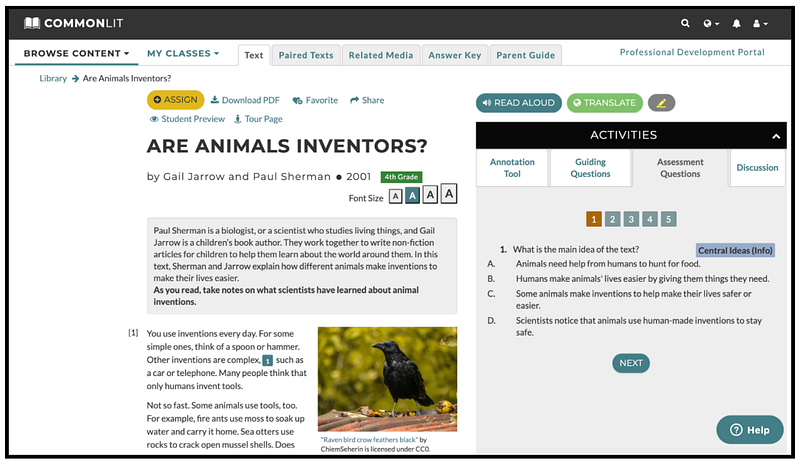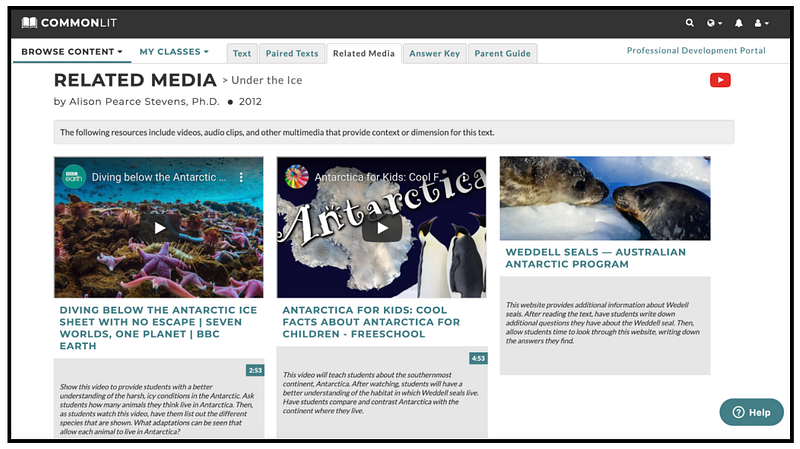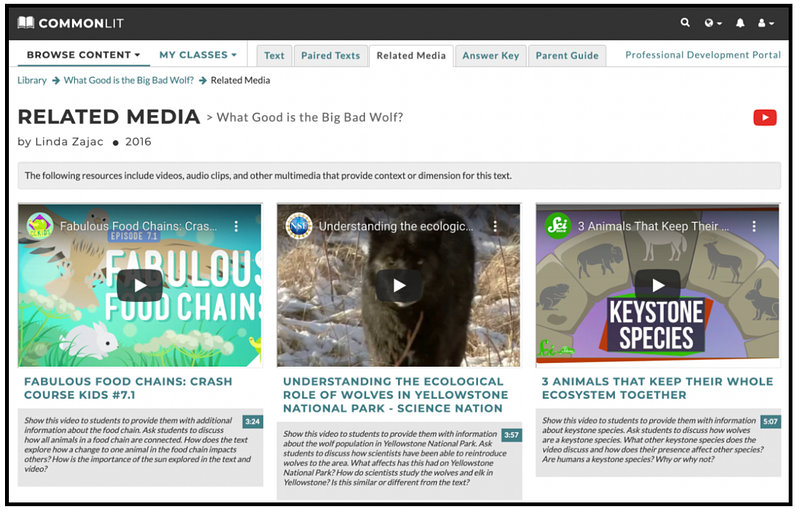These informational texts for grades 3–5 foster students’ curiosity about the animal world!
The animal world sparks questions for kids of all ages. Why do giraffes have such long necks? What is the difference between an alligator and a crocodile? How do caterpillars turn into butterflies? Reading about animals in the classroom is a great way to foster students’ curiosity by helping them answer questions and generate more!
Here is a great selection of informational texts for grades 3–5 from CommonLit about a variety of animals to help your students build background knowledge and learn new facts!
“Are Animals Inventors?” by Gail Jarrow and Paul Sherman (4th Grade)
This article explores how animals like chimpanzees, naked mole-rats, and ravens use inventions to make their lives easier. Scientists study animals in nature to determine whether they are born knowing how to use tools, or whether they copy inventions other animals have made before.
While students read, have them follow the annotation task, which asks them to take notes on what scientists have learned about animal inventions. After reading, students can use their notes to discuss the ways these inventions help various animals survive.

“Beetles with Brawn” by Melissa Stewart (5th Grade)
This text describes the rhinoceros beetle, a type of insect that is much stronger than it seems. The insect’s name comes from its headgear, which resembles a rhino’s horn. However, the rhinoceros beetle is mostly known for its super strength — it can support up to one hundred times its own weight!
After reading, have students make connections between the rhinoceros beetle and other bugs or animals they know. Ask Discussion Question 2, “We often think that being big and being strong are connected. How does the rhinoceros beetle prove this wrong? Can you think of any other things that are small, but mighty?” Students can discuss ways the rhinoceros beetle and other animals are more powerful than they seem.
“Flopping Frogs” by Pamela Brunskill (3rd Grade)
In this text, Pamela Brunskill explains what scientists have learned about the tailed frog. Tailed frogs are unique because they land on their stomachs when they jump and then bring their back legs in to prepare for another jump. This special way of moving helps tailed frogs evade predators around the streams where they live.
After reading, have students discuss the importance of learning about animals. Ask Discussion Question 1, “What can humans learn from studying animals, like Dr. Essner does in this text? Can you think of any other animals that are, or should be, studied? Why do you think studying these creatures is important?” Students can share their ideas about researching animals and, as an extension, could choose an interesting animal to learn about on their own.
“The Dental-Floss Fish” by Craig Stevens (4th Grade)
In this informational text, Craig Stevens explains the important job Hawaiian cleaner wrasse fish do for the ocean. The Hawaiian cleaner wrasse is a small, brightly colored fish that lives in coral reefs. It uses its sharp teeth to eat parasites attached to the bodies and mouths of various other fish, moray eels, and even sharks.
As students read, have them follow the annotation task, which asks them to take notes on the jobs that the Hawaiian cleaner wrasse does for the animals in the ocean. After reading, students can use their notes to discuss the benefits of the relationships between the cleaner wrasse and the other animals in the text.
“Under the Ice” by Alison Pearce Stevens, Ph.D. (3rd Grade)
In this text, Dr. Alison Pearce Stevens describes how Weddell seals survive in the cold ocean waters off the coast of Antarctica. Weddell seals have thick fur and blubber that keep them warm. As seal pups grow, their mothers teach them how to dive under the ice and hunt for food.
Before reading this text, have students watch the video “Antarctica for Kids: Cool Facts about Antarctica for Children” under the Related Media tab to build background knowledge about where Weddell seals live. Have students share what they learned about Antarctica and the animals that live there.

“Flying with Arctic Terns” by Rebecca Hirsch (4th Grade)
In this text, Rebecca Hirsch describes the life of an Arctic tern, a type of bird similar to a seagull. Arctic terns need warm temperatures to hunt for food. Though these birds are tiny, they complete the largest migration of any animal on earth. Arctic terns fly all the way across the globe, from the Arctic to Antarctica, every year!
As students read, have them follow the annotation task, which asks them to take notes on why arctic terns migrate. After reading, students can use their notes to discuss how arctic terns survive in their environment and what makes their migration remarkable.
“What Good is the Big Bad Wolf?” by Linda Zajac (5th Grade)
This informational text describes a “natural experiment” through which scientists learned valuable information about food chains. The scientists studied a town that had lots of elk but almost no wolves, and a wild habitat that had lots of wolves that hunted elk. They learned that in the town, the lack of wolves meant that the elk herd grew out of control, and the whole ecosystem was negatively affected. In the wild area, the presence of the wolves meant the plants and animals in the ecosystem kept the habitat in balance. It turns out, wolves are not so “big and bad” after all!
After reading the text, have students watch the video “3 Animals that Keep Their Whole Ecosystem Together” under the Related Media tab. Using evidence from the text and the video, ask students to discuss how wolves are a keystone species in their ecosystem. Then, students can compare and contrast wolves with the other keystone species in the video.

“The Alligator’s Super Sense” by Ana María Rodríguez (4th Grade)
In this informational text, the author shares interesting facts scientists have learned about alligators. Alligators are master hunters, and Dr. Daphne Soares wanted to know more about how they capture their prey. She conducted an experiment and found that the black bumps on alligators’ faces help them sense changes in pressure so they know when to chomp down on their prey.
After reading this text, have students consider why it is important for humans to study animals. Ask Discussion Question 1, “What can humans learn from studying animals? What kind of animal would you like to study? Why do you think studying different animals is important?” Students can share fun facts they know about different animals too!
“Play, Play Again” by Ellen Braaf (5th Grade)
In this informational text, the author describes why young animals play with each other and how the skills developed during playtime help animals survive. Young predator animals practice skills that will help them hunt their prey, while prey animals practice the movements they will need to escape from predators. Play also helps animals test their physical limits, improve their flexibility, and may even help their brains grow.
When they read this text, students can make connections between animal play and their own experiences playing with friends. Have them watch the video “Children Speaking about the Importance of Play” under the Related Media tab. Ask students to compare and contrast why animals and humans play. Students can discuss what skills they think children develop when they play, and how those skills are similar to and different from the skills animals develop in the text.
Next Steps
Interested in more amazing lessons about animals? Check out our Target Lessons About Protecting Animals or our CommonLit library for more resources!
If you’re interested in learning all about CommonLit’s free digital literacy program, join one of our upcoming webinars!


